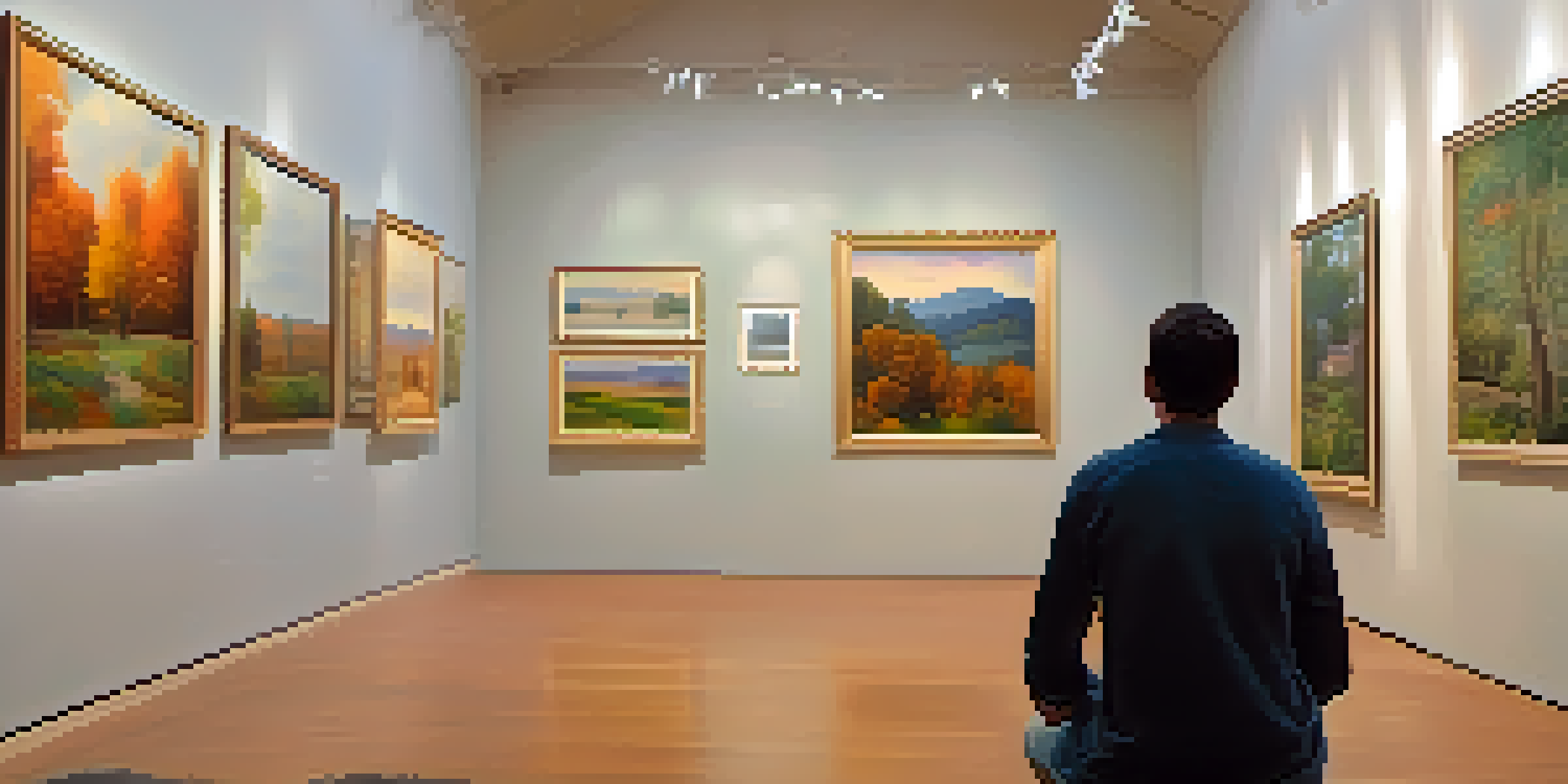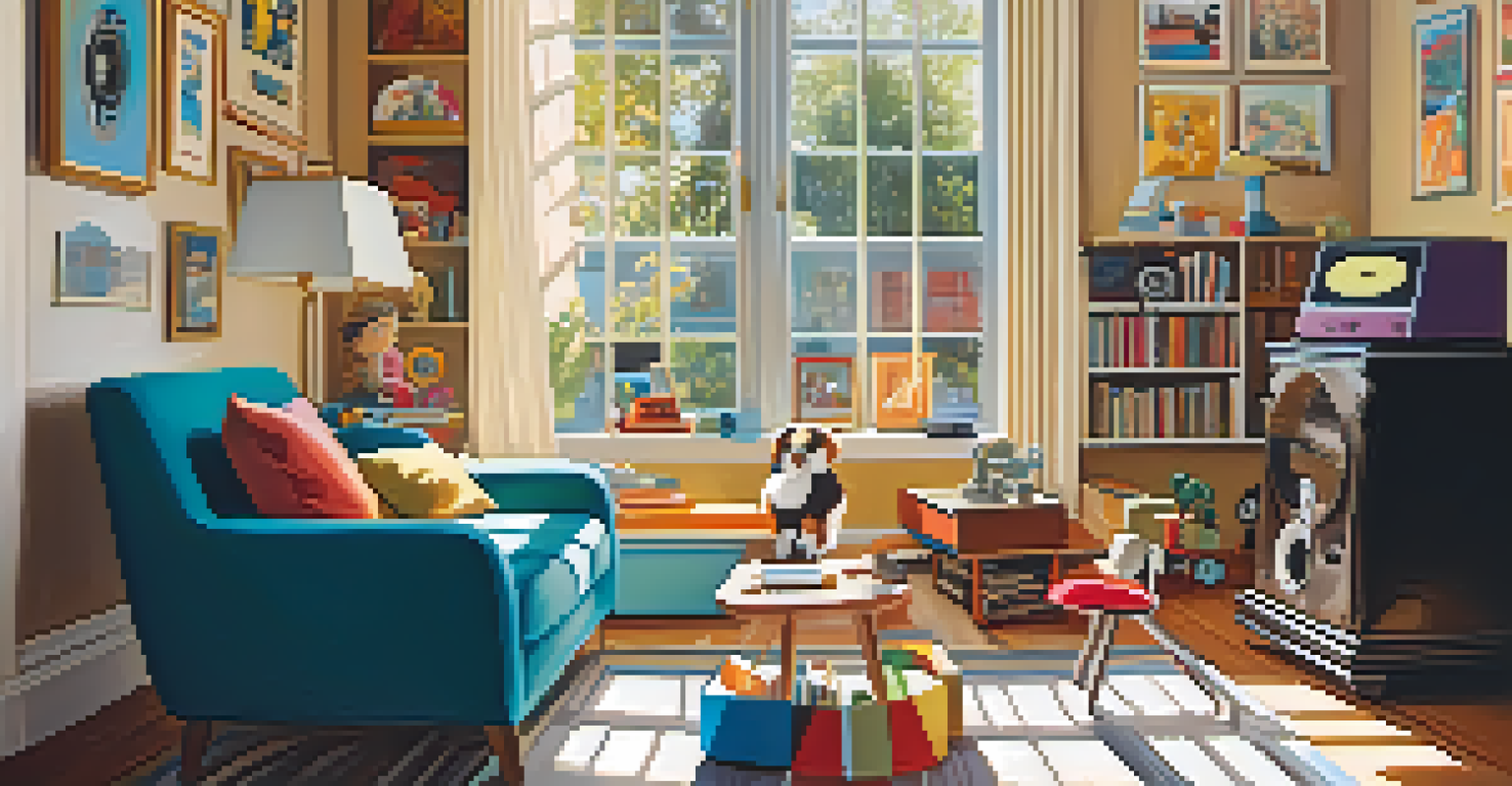Art and Memory: The Role of Sound in Creating Atmosphere

Understanding the Connection Between Art and Memory
Art has a unique ability to evoke memories, often transporting us back to specific moments in time. Think about how a song can instantly remind you of a summer day spent with friends or a piece of art can spark a recollection of a family vacation. This connection demonstrates how our senses interplay, where visual impressions are often intertwined with auditory experiences.
Art is the most beautiful of all lies; it is the truth that we are in search of.
Memory is not just a mental construct; it’s also a sensory experience. When we encounter art, it’s not solely the visual elements that impact us. Sounds associated with a piece—like the rustle of leaves in a landscape painting or the distant chatter in a bustling city scene—can enhance our emotional responses and recollections.
By understanding this connection, artists can create works that resonate on multiple levels. Sound can serve as a powerful backdrop, enriching the viewer's experience and deepening their emotional engagement with the art.
The Role of Sound in Shaping Atmosphere
Sound plays a crucial role in setting the atmosphere around art. Just as lighting can highlight specific features of a painting, sound can evoke feelings that elevate the experience. Imagine walking into a gallery where soft music plays; this creates a serene environment that encourages contemplation and appreciation.

Conversely, sounds that are jarring or unexpected can disrupt the atmosphere, pulling viewers out of their immersive experience. For instance, a loud crash or sudden interruption in a quiet space can create tension, altering how we perceive the artwork in front of us.
Art Evokes Memories Through Sound
Art and sound work together to create rich sensory experiences that enhance emotional connections and memory recall.
In essence, sound can act as a bridge, connecting the viewer to the emotions intended by the artist. This dynamic interplay between sound and atmosphere can make a profound impact on how art is experienced and remembered.
Examples of Sound in Artistic Installations
Many contemporary artists utilize sound strategically in their installations to create a specific atmosphere. For instance, artist Janet Cardiff is known for her audio walks, where listeners engage with soundscapes that transform their surroundings into an immersive narrative. This blending of sound and space invites viewers to explore art in a multi-dimensional way.
Sound is the vocabulary of nature.
Another example is Olafur Eliasson, who integrates natural elements and sound to create immersive experiences. His installations often feature water, light, and sound, encouraging visitors to reflect on their surroundings while becoming aware of their own memories and emotions.
These examples illustrate how sound can transform a passive viewing experience into an active exploration. When sound is thoughtfully incorporated, it enhances the atmosphere and deepens the connection between the viewer and the artwork.
The Psychological Impact of Sound on Memory
Research suggests that sound can significantly enhance memory recall. This phenomenon, known as the 'Mozart effect,' demonstrates how listening to certain types of music can improve cognitive function and memory retention. In the context of art, sound can trigger memories that are linked to specific experiences or emotions.
For example, you might recall childhood memories of playing in the park when you hear the sound of laughter or a distant ice cream truck. This connection can be further amplified in an art piece that incorporates familiar auditory elements, making the overall experience more memorable.
Sound Shapes Art Atmosphere
The incorporation of sound in art installations sets the atmosphere, influencing how viewers perceive and engage with the artwork.
Understanding this psychological impact allows artists and curators to craft experiences that resonate deeply with audiences. By weaving sound into the fabric of art, they can create a richer, more memorable engagement.
Cultural Influences on Sound and Memory
Cultural backgrounds can shape the way we perceive sound and its connection to memory. For instance, traditional music from different cultures can invoke specific memories related to family gatherings or celebrations. This cultural context adds another layer to how sound interacts with art and memory.
Artists often draw upon cultural sounds to evoke emotions and memories that resonate with diverse audiences. For example, incorporating sounds from a specific culture can enhance the authenticity of an artwork and foster a deeper connection with viewers who share that background.
Recognizing cultural influences helps us appreciate the varied ways sound enriches artistic experiences. It encourages artists to explore these connections, creating works that resonate on both personal and communal levels.
Soundscapes: The Art of Sonic Experience
Soundscapes are carefully curated audio environments that can transform the way we experience art. These immersive audio experiences can transport us to different places or evoke specific moods, making them a powerful tool for artists. Think of an installation that replicates the sounds of a rainforest—chirping birds and rustling leaves—creating an atmosphere that draws viewers into the artwork.
Such soundscapes allow artists to tell stories that might not be fully expressed through visual elements alone. They create a narrative that engages the audience’s imagination, prompting them to explore the artwork from multiple angles.
Cultural Context Influences Perception
Cultural backgrounds shape our understanding of sound, enriching the memory and emotional responses elicited by art.
This fusion of sound and visual art not only enhances the atmosphere but also enriches the narrative experience, inviting viewers to become active participants in the storytelling process.
The Future of Sound in Art and Memory
As technology advances, the potential for sound in art continues to expand. Virtual reality (VR) and augmented reality (AR) are revolutionizing the way we experience art, allowing for interactive soundscapes that respond to our movements and choices. This technology creates immersive environments where sound, art, and memory intertwine in unprecedented ways.
Artists are beginning to experiment with these technologies, creating dynamic installations that encourage viewers to engage with art on a personal level. Imagine stepping into a VR experience where the sounds of your childhood play as you navigate through familiar landscapes.

Looking ahead, the integration of sound in art will likely become even more sophisticated, offering new avenues for exploring memories and emotions. This evolution promises to deepen our understanding of the relationship between art, sound, and the human experience.